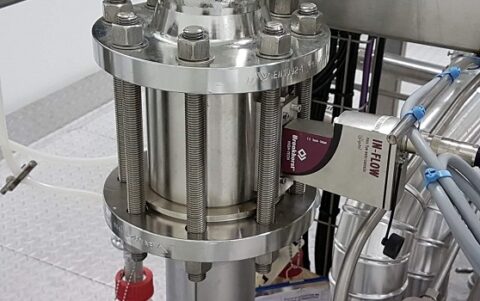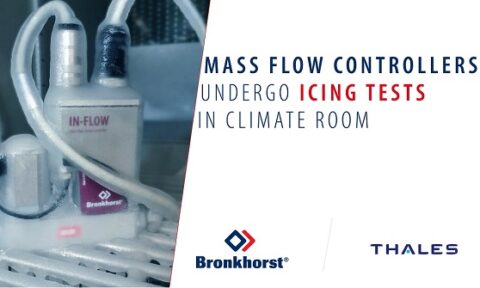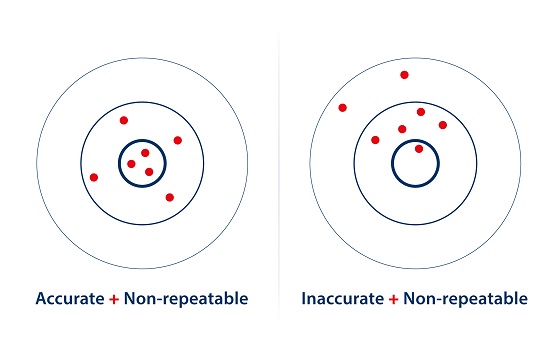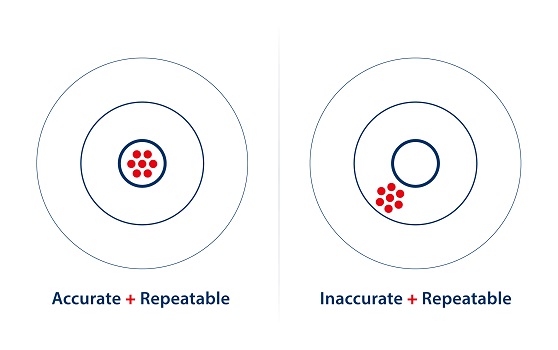Flow Meters Guide
What is a flow meter?
- What is a flow meter?
- How does a flow meter work?
- Examples of applications in which flow meters are used
- How to select the best flow meter?
- ♦ Phase of the fluid: gas/liquid/vapour
- ♦ For which fluid do you use the flow meter?
- ♦ What is the flow rate?
- ♦ What is the inlet and outlet pressure?
- ♦ What is the ambient temperature and the temperature of the fluid?
- ♦ What is the location of the flow meter?
- What do you want to achieve with your flow meter?
- ♦ Performance versus price
- ♦ Flow meter accuracy versus repeatability
- ♦ Flexible use
- Which process conditions can be relevant?
How to start selecting a flow meter
First you need to know what aspects you should consider when selecting a flow meter. Before you start to select the right flow meter, it is necessary to know what the purpose is of your application. Are you measuring gas, liquid or vapour?
But, let’s start by explaining a bit more about what flow meters are, how they work, what they are used for and the criteria to select the best flow meter for the application.
1. What is a flow meter?
A flow meter is an instrument that measures a mass or volumetric flow rate of a gas or liquid. You might have come across a variety of terms when referring to a flow meter, such as flow sensor, mass flow meter, mass flow controller, flow regulator etc.
The purpose of a flow meter is basically to measure the flow of gas or liquid between two points in a process. Sometimes it is necessary to control or regulate the flow. This is done by combining a flow meter with a valve, creating a flow controller. In this case, besides measuring a flow, you can also control it to change the flow rate. The output can help you better understand your process to make decisions regarding product quality, speed of process and cost reduction.
2. How does a flow meter work?
There are two basic types of fluid measurement – mass and volume flow measurement. The volumetric flow measurement is temperature and pressure dependent especially for gas and will be shown in units of volume such as ml/min or m3/h. When measuring mass flow, you see units of mass such as kg/h or g/min. Alternatively, because gas is compressible, it is more convenient to express mass flow as standardised volumes, e.g. mls/min or m3n/h. Therefore, you can either choose a mass flow meter or a volumetric flow meter for your application.
Besides these two types of measurement, there are different measuring principles that all have their specific advantages and disadvantages:
Mass flow measuring principles
- Thermal measuring principle: in this category we distinguish three sensor principles:
- Coriolis measuring principle
Coriolis mass flow measuring principle
Volume flow measuring principles
- Ultrasonic flow measurement
- Vortex
- Magnetic inductive
- Differential Pressure
- Positive displacement
Thermal Mass Flow Meter/Controller for Gas (by-pass design).
Gas & liquid flow meters
Some flow meters are developed for gas, some specially for liquid. There are also flow meters available on the market that are independent of the fluid properties and can therefore handle both gas and liquids.
You can find a glossary page on our website, in which you will find many terms and abbreviations that are common in the field of flow measurement.
3. Examples of applications in which flow meters are used
Flow meters are used in a wide variety of applications; here are some examples:
4. How to select the best flow meter for your application?
In this paragraph, we will discuss some of the key factors involved into choosing a flow meter. In doing so, we consider the differences between various measurement principles. Read below what to consider when selecting a flow meter. There is a big difference between lab and industrial applications but most of the considerations are required for both application fields.
Phase of the fluid: gas/liquid/vapour
Some flow meters can be easily eliminated because they simply will not work with the application. For example, electromagnetic flow meters will not work with hydrocarbons and require a conductive liquid to function. Many flow meters cannot measure vapours or slurries.
Here are some of the main flow meter categories paired with the fluid type the meters can handle:
- Gas – Thermal Mass, Coriolis Mass, Ultrasonic, Variable Area, Variable Differential Pressure, Positive Displacement, Turbine
- Liquid – Coriolis Mass, Ultrasonic, Thermal Mass, Variable Differential Pressure, Positive Displacement, Turbine, Electromagnetic
- Vapour – Vortex, Ultrasonic, Coriolis, Diaphragm and Floating Element
What is the flow rate?
The flow rate is usually the most important specification to consider when selecting a flow meter. Fluid quantity can be displayed in volume, standardised volume and true mass units. The flow rate is the quantity of fluid per unit time flowing through a measuring device.
Check out the blog to find out why it is important to know what reference conditions you are working with. A supplier usually indicates the minimum and maximum full-scale range of a product series. This should meet your process requirements.
For which fluid do you use the flow meter?
Chemical and physical properties of the medium can influence the material of the flow meter and therefore the working of the instrument. Commonly, the following wetted parts (parts that are exposed to or in direct contact with the medium) may be offered:
- aluminium
- stainless steel
- hastelloy and
- monel in combination with Viton (FKM), Kalrez (FFKM) or EPDM elastomer seals
Please note that MEMS or CMOS (chip) sensors which are applied in some gas flow meters, are only suitable for a limited number of non-aggressive gas types.
Another aspect you must consider is the viscosity of the fluid, the density and dispersion (solid content). Not all measurement technologies can be used for all fluids. For example, electromagnetic flow meters can only be applied for conductive liquids.
What is the inlet and outlet pressure?
When selecting a flow meter, it is important to know whether you need a low pressure drop or not. The pressure drop is defined as the difference between the inlet and outlet pressure. In addition, flow meters have a maximum operating pressure. If you have a high-pressure application, you need to take this pressure rating into consideration.
In the case of mass flow control, the inlet pressure (P1) and outlet pressure (P2) are required for the selection and dimensioning of the most appropriate control valve.
What is the ambient temperature and the temperature of the fluid?
The temperature of your fluid and the instrument’s environment are the next factors to check.
Variations in fluid temperature may affect the accuracy of your measurement. In the case of temperature fluctuations, it could be interesting to select a flow meter with temperature compensation (e.g. the EL-FLOW Prestige flow meters).
Too high or too low environment temperatures may also harm the electronic components of your flow meter during operation or storage. When you use a flow meter in a furnace or burner application, or in areas with very low temperatures, it is important to check whether the instrument can withstand these extreme temperatures. So, check the temperature specifications as provided by the supplier before selecting your flow meter.
What is the location of the flow meter?
When selecting your flow meter, you must consider where you will install it, whether indoors, outdoors, in a laboratory or for a particular industry. For laboratories, other specifications apply than for the oil and gas industry.
♦ NEMA
♦ Whether you need specific certificates or approvals for the area in which you are installing the flow meter. For example: ATEX or IECex certificated (use hazardous area) or FDA approval, etc. Check the list of certificates available for our Bronkhorst flow meters.



5. What do you want to achieve with your flow meter?
When selecting your flow meter, you need to consider what is important in your process. What do you want to achieve?
Performance versus price
The most common criteria for selecting a flow meter are price and performance. If you place priority on price, you are likely to get a basic instrument, with less than average performance.
Besides the price of the component, installation, maintenance, and repairs over time should also be included in calculating the total cost of ownership. How much the meter costs to operate, such as its electrical consumption, can also increase the overall cost of the flow meter.
Flow Meter Accuracy versus Repeatability
The specifications of the flow meter must be considered when selecting a flow meter. Accuracy and repeatability are important specs to look at.
Flow Meter Accuracy
Accuracy is how close the measurement is to the true value. For flow meters, the measured deviations are often visualised on a calibration certificate. This is expressed as a percentage, e.g., ±1%. Not all flow meters offer the same accuracy, but not all applications require the highest possible accuracy. Nevertheless, absolute accuracy is important in quantitative research and development or catalytic applications.

Flow Meter Repeatability
Repeatability is producing the same outcome given the same conditions. In other words, a flow meter should produce the same readings when operated under the same variables and conditions. This, too, is expressed as a ± percentage. This is particularly important for burner applications, for example.

Flexible use
Sometimes it makes sense to select a flow meter that can be used in multiple applications. For example, when you need an instrument in a research project and you know that other projects will follow in the future, but you have no idea what fluids are used then. In such case, it can be beneficial to select a flow meter that is fluid independent and has a wide flow range as well.
If you have an application with high fluctuations in flow rate, you will probably prefer a flow meter with a high turndown ratio. Turndown ratio is also commonly referred to as rangeability. This indicates the range in which a flow meter or controller can accurately measure the fluid. In other words, it’s simply the high end of a measurement range compared to the low end, expressed in a ratio and is calculated using a simple formula: Turndown Ratio = maximum flow / minimum flow. Read more about turndown ration in our FAQs.
6. Which process conditions can be relevant?
Cleaning
In the food and beverage and pharmaceutical industry, cleaning your instrumentation is important to avoid cross contamination. Clean-in-place (CIP) is a method of cleaning the interior surfaces of pipes, vessels, equipment, filters, and fittings. A typical CIP cycle consists of various steps including washing with a hot cleaning agent and hot acid with temperatures up to 95°C. Steam-in-place, also referred to as sterilisation-in-place (SIP), consists of a phase in which the instrument is sterilised with saturated steam with a temperature up to 140 °C. Not all flow meters are suitable for these cleaning methods, so this is an important factor to consider when applicable. Please also note that these markets often require the application of FDA approved seals as well.
Available space
Is space limited in your process? Then select a flow meter that is compact and does not require a straight run of pipe at the inlet or outlet. There are ultra-compact flow meters on the market based on MEMS technology (e.g. the IQ+FLOW gas flow meter).

Mounting of the flow meter
Before selecting a flow meter it is essential to check where to locate and how to position the instrument in your installation. The accuracy of some instruments may be more affected by its mounting position than others. Other relevant aspects with respect to the mounting of flow meters may be disturbances caused by vibrations, crosstalk, pressure shocks and the effects of bends, valves and reductions of pipe diameters up- and downstream of the instruments. These effects may also vary per operating principle.
Communication options
Check whether you need a digital or analog flow meter. You also need to know what type of communication is used in your system. Popular types of fieldbus communication are Profinet, EtherCAT, CANopen, Ethernet/IP and POWERLINK but also the more established versions such as Modbus, Profibus and DeviceNet can be integrated. There is also the possibility of using a manufacturer’s own fieldbus communication, such as Bronkhorst’s FLOW-BUS. Using FLOW-BUS has the advantage of a simple and cost-effective network setup that can be used with FlowSuite and other Bronkhorst software.
Moisture
Some flow meters are more sensitive to moisture or particles than others. Appropriate filtering to protect your instruments may be a good investment, saving costs for cleaning, repair, interruption of your process and possibly also the waste of raw material or finished product.
So finally, understanding how a flow meter works, selecting the best instrument for your specific application, and understanding the purpose of your application are the key factors in optimizing your flow measurement process.
Selecting the best flow meter involves crucial factors, such as the specific fluid properties, flow rate requirements, fluid temperature, inlet and outlet pressure as well as environmental conditions. Besides that, process conditions like cleaning requirements, available space, assembly considerations and communication options should also be taken into account.
If you’re interested in learning more about flow meters and their applications, check out our comprehensive blog post.

